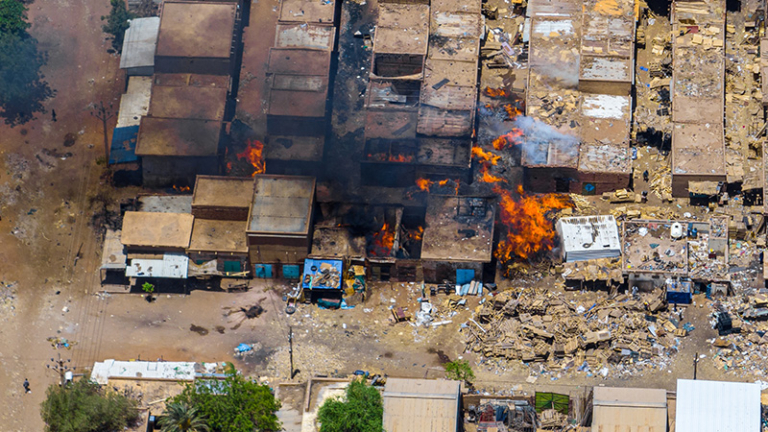
In April 2023, violence broke out in Sudan’s capital Khartoum in a power struggle between Abdel-Fattah al-Burhan, leader of the Sudanese Armed Forces (SAF), and Mohamed Hamdan Dagalo, known as Hemedti, commander of the Rapid Support Forces (RSF). The RSF was once a unit in the SAF that grew out of the Janjaweed, the notorious militia that committed ethnic cleansing in Darfur on behalf of the Sudanese government in 2003. The two factions came into conflict over a dispute over leading the country and controlling its rich resources. Their dispute triggered a war that has plummeted the country into 18 months of horror from which there appears to be no respite. The war has claimed the lives of more than 20,000 people and has produced one of the world’s worst humanitarian crises. According to the United Nations Office for the Coordination of Humanitarian Affairs, the conflict has forced more than 11 million people from their homes—nine million of whom became internally displaced—earning the country the appalling accolade of having the most internally displaced people anywhere. Some 25.6 million people, or half of Sudan’s population, face acute hunger and almost a million are on the brink of a famine the likes of which the world has not seen in the past forty years.
Protracted displacement that devastates the dignity and quality of life of those who endure it is not a natural consequence of violence or disaster. Rather, just like the war itself, displacement on the scale occurring in Sudan is the product of long histories of exploitation and neglect at the hands of national, regional, and international actors. It is the consequence of a system of racial capitalism that values power and profit over human lives, Black lives, at whose expense this power and profit is accrued.
The Production of War and Displacement
Media coverage and international aid organizations often characterize displaced people as primarily humanitarian cases, isolated from the political conflicts that forced them from their homes. The solutions offered often are basic aid, in the form of tents, food, potable water, or education and healthcare. Such support is indeed crucial. But the rhetoric that surrounds it serves to depoliticize and obscure culpability for the horrors that these humans endure. To understand displacement in Sudan is to understand the political conditions that have produced it.
Many observers have described the war in Sudan as a counterrevolutionary undoing of the gains of the Sudanese people.
Many observers have described the war in Sudan as a counterrevolutionary undoing of the gains of the Sudanese people who rose up to demand madaniya—full civilian rule accompanied by equitable distribution of state assets unfairly monopolized by military strongmen. The revolutionaries were successful in removing former dictator Omar Al-Bashir in 2019, but later the military staged a coup in 2021 against an interim transitional government that was to be turned over to civilians. The period that followed saw conflicts within the military over who would control the country’s wealth, conflicts that led the current war between the RSF and SAF.
Some commentators have argued that the war must be understood within a longer history of what they call Sudan’s “marginalization, extraction, and militarization.” Before Sudan’s independence, British colonial violence ruled through sowing division and discord, and structured a world where the lives of the once-colonized Black and brown people were never valued as much as those of the white colonizer. Neither the United Nations nor the African Union has intervened effectively to stop weapons from entering the country. Regional actors—including Egypt, Israel, Saudi Arabia, and the United Arab Emirates— have also been propping up local Sudanese military factions because they too stand to gain from their theft of the country’s resources. Sudan’s gold mining is a particular target: in 2022, the value of its gold exports was estimated at $2 billion—more than half of total national exports.
Regional and international players have not only failed to stop the war, they also have failed to provide anything close to sufficient aid. Humanitarian assistance is arriving “too little and too late” according to aid groups. Recent accounts showing that even by generous estimations, only 52 percent of the aid requirement expressed earlier in the war was funded through contributions from the United States, European Union, and the United Kingdom—all implicated in the country’s colonial legacy— and from the United Arab Emirates, which has actively worked against peace by arming the RSF.
Meanwhile, the difficult conditions that Sudanese youth were protesting before Bashir’s ouster have worsened, including rising inflation, unavailability of basic foodstuffs, and abandoned infrastructure projects that served to line the pockets of the military elite. These same factors affect the realities of displacement today. Aid is thwarted not only by the persistent violence, and by the RSF and SAF’s use of starvation as a weapon of war, but also by the absence of infrastructure to move goods and services to their intended destinations. Rampant inflation and a 50 percent drop in the value of the national currency make it even harder for people to access essential foods and goods. The healthcare system has been destroyed.
Describing Displacement
Today one in every 69 people globally are displaced. Over half of those displaced remain inside their own countries, which makes Sudan’s accolade of having the most internally displaced people in the world particularly alarming. Internal displacement leaves people near the conditions from which they fled—whether climate degradation, persecution, or war. Often people experience these conditions simultaneously.
This is the case in Sudan, where the material horrors of war and displacement are hard to overstate. They are exacerbated by flooding caused by the climate crisis, which has affected over 125,000 people in the country. They are also worsened by the spread of disease, including measles and cholera due to the destruction of medical services and the deterioration of living conditions. All these factors have interrupted children’s schooling. Women have reported increased gender-based violence as a tool of war and a function of displacement and lack of safe space.
Sudan has long accommodated displaced people, both those within its own borders fleeing violence in Darfur or the Nuba Mountains in South Kordofan, and those fleeing conflicts in surrounding countries such as South Sudan, Ethiopia, and Eritrea. According to the International Organization for Migration, prior to the current war 3 million people were displaced in Sudan, an already staggering number. Some non-Sudanese have since returned to their countries of origin or moved elsewhere. As a result of this war, over a quarter of all displaced people in Sudan have experienced secondary displacement. Since the start of the war, however, an additional 8.1 million people have become internally displaced. Prior to the war, internally displaced people (IDPs) resided in the Darfur and Kordofan regions, but today there are IDPs in all 18 Sudanese governorates, in an estimated 9,269 locations across the country. Over a third hail from the state of Khartoum, where the capital is located and where the current violence began. Whole neighborhoods in Khartoum reportedly have been vacated.
For people who are internally displaced, aid is not coming. Internal displacement camps, already overflowing before the war, have reached new levels of overcrowding. The International Rescue Committee has reported that one of Sudan’s largest such camps, Zamzam, which hosts over half a million people, is facing famine conditions. There has been no food assistance in the camp since April, and with soaring food prices, people are unable to purchase food themselves. Children are particularly susceptible to starvation, which makes them less able to defend against the rampant spread of infectious diseases, a terrifying prospect as healthcare services are unavailable.
The difficult conditions that Sudanese youth were protesting before Bashir’s ouster have significantly worsened.
For those people who had the desire and the legal, financial, and health resources to seek refuge outside of the country, journeys are difficult. Approximately 2.9 million people have crossed the Sudanese border to refuge since April 2023. As of October 2024, according to the United Nations Higher Council for Refugees (UNHCR), more than half a million had gone to Chad, 800,000 to South Sudan, and more than one million to Egypt, while others have sought refuge in Libya, Uganda, Ethiopia, and the Central African Republic. Importantly, these journeys have been structured by borders that are hostile to people on the move, which has forced many to illegally cross borders in search for shelter from atrocities.
At the start of the war women, children, and the elderly were allowed entry into Egypt without a visa, but now every entrant requires one. Despite agreements guaranteeing the freedom of movement for citizens of Sudan and Egypt, Sudanese attempting to make the journey are forced to pay $1,500 – $2,500 per person to crossan incredibly steep price for people who have been suffering years of inflation and economic deprivation. A search for “Sudan” on the website gofundme.com shows hundreds of Sudanese families raising funds to be able to make this arduous trip.
Travel to Saudi Arabia or Chad is also fraught. Saudi Arabia is now open to those with foreign passports, offering short-term visas, but does not have a precedent or a system for hosting refugees. Those who fled to Chad face extremely limited support. Doctors Without Borders reports dire conditions of food deprivation, acute malnutrition, emaciated babies, and other healthcare tragedies due to a lack of resources available for those seeking refuge in Chad. Meanwhile, there is no mass refuge offered in wealthy European countries or the United States for Sudanese people.
Beyond a Ceasefire
The calls for ceasefire have also been urgent in the case of Sudan. Without one, people will die from wholly preventable hunger, easily treatable diseases, and living conditions that no human being should endure. Without a ceasefire, war crimes by both sides will continue, including indiscriminate bombing, arrest and torture, starvation, and impeding aid delivery.
Still, a ceasefire would fall dramatically short of what the people of Sudan have fought for or imagined for themselves. They have demanded self-governance and respect, as well as a say in how their nation’s resources are distributed. The Sudanese people have fought against being pawns in a military hegemon’s calculus, or in a regional equation that ends in profit. They have dreamed of an existence in which they are not victims of what feminist geographer Ruth Wilson Gilmore has called “organized abandonment,” a process of intentional divestment from people of color that creates opportunities for revenue extraction. They have dreamed of a life where they are not the victims of wanton violence for another’s profit.
The global displacement crisis is worsening precipitously. For each of the last twelve years, the number of displaced people in the world has broken the prior year’s record. Today there are 117 million people worldwide who are victims of climate disaster, wars for profit or power, economic devastation through exploitation, or a mixture of all these factors and more. While the wealthiest around the world benefit from these horrors, the most marginalized who have been violated and abandoned—in Sudan, Gaza, the Democratic Republic of Congo, Haiti, Bangladesh, and elsewhere—pay the highest price.
The views expressed in this publication are the author’s own and do not necessarily reflect the position of Arab Center Washington DC, its staff, or its Board of Directors.
Featured image credit: Shutterstock/Abd Almohimen Sayed

